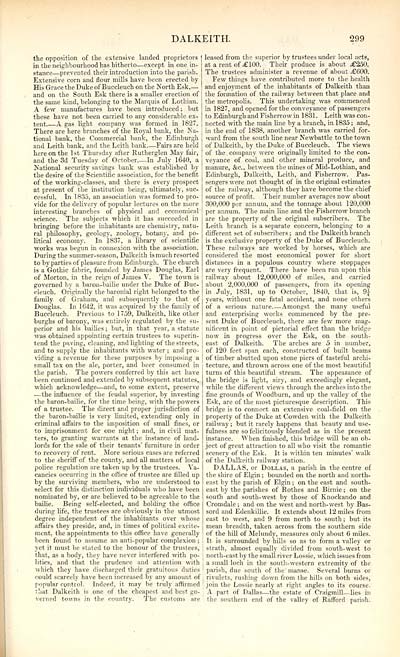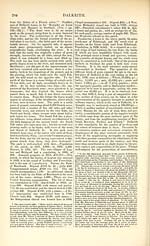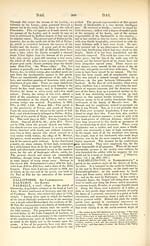Topographical, statistical, and historical gazetteer of Scotland > Volume 1
(381) Page 299
Download files
Complete book:
Individual page:
Thumbnail gallery: Grid view | List view

DALKEITH.
299
the opposition of the extensive landed proprietors
in the neighbourhood has hitherto — except in one in-
stance — prevented their introduction into the parish.
Extensive corn and flour mills have been erected by
His Grace the Duke of Buccleuch on the North Esk, —
and on the South Esk there is a smaller erection of
the same kind, belonging to the Marquis of Lothian.
A few manufactures have been introduced ; but
these have not been carried to any considerable ex-
tent A gas light company was formed in 1827.
There are here branches of the Royal bank, the Na-
tional bank, the Commercial bank, the Edinburgh
and Leith bank, and the Leith bank Fairs are held
here on the 1st Thursday after Rutherglen May fail-,
and the 3d Tuesday of October In July 1640, a
National security savings bank was established by
the desire of the Scientific association, for the benefit
of the working-classes, and there is every prospect
at present of the institution being, ultimately, suc-
cessful. In 1835, an association was formed to pro-
vide for the delivery of popular lectures on the more
interesting branches of physical and economical
science. The subjects which it has succeeded in
bringing before the inhabitants are chemistry, natu-
ral philosophy, geology, zoology, botany, and po-
litical economy. In 1837, a library of scientific
works was begun in connexion "with the association.
During the summer-season, Dalkeith is much resorted
to by parties of pleasure from Edinburgh. The church
is a Gothic fabric, founded by James Douglas, Earl
of Morton, in the reign of James V. The town is
governed by a baron-bailie under the Duke of Buc-
cleuch. Originally the baronial right belonged to the
family of Graham, and subsequently to that of
Douglas. In 1642, it was acquired by the family of
Buccleuch. Previous to 1759, Dalkeith, like other
burghs of barony, was entirely regulated by the su-
perior and his bailies ; but, in that year, a statute
was obtained appointing certain trustees to superin-
tend the paving, cleaning, and lighting of the streets,
and to supply the inhabitants with water ; and pro-
viding a revenue for these purposes by imposing a
small tax on the ale, porter, and beer consumed in
the parish. The powers conferred by this act have
been continued and extended by subsequent statutes,
which acknowledge — and, to some extent, preserve
— the influence of the feudal superior, by investing
the baron-bailie, for the time being, with the powers
of a trustee. The direct and proper jurisdiction of
the baron-bailie is very limited, extending only in
criminal affairs to the imposition of small fines, or
to imprisonment for one night; and, in civil mat-
ters, to granting warrants at the instance of land-
lords for the sale of their tenants' furniture in order
to recovery of rent. More serious cases are referred
to the sheriff of the county, and all matters of local
police regulation are taken up by the trustees. Va-
cancies occurring in the office of trustee are filled up
by the surviving members, who are understood to
select for this distinction individuals who have been
nominated by, or are believed to be agreeable to the
bailie. Being self-elected, and holding the office
during life, the trustees are obviously in the utmost
degree independent of the inhabitants over whose
affairs they preside, and, in times of political excite-
ment, the appointments to this office have generally
been found to assume an anti-popular complexion ;
yet it must be stated to the honour of the trustees,
that, as a body, they have never interfered with po-
litics, and that the prudence and attention with
which they have discharged their gratuitous duties
could scarcely have been increased by any amount of
popular control. Indeed, it may be truly affirmed
that Dalkeith is one of the cheapest and best go-
verned towns in the country. The customs are
leased from the superior by trustees under local acts,
at a rent of £ 100. Their produce is about £250.
The trustees administer a revenue of about £600.
Few things have contributed more to the health
and enjoyment of the inhabitants of Dalkeith than
the formation of the railway between that place and
the metropolis. This undertaking was commenced
in 1827, and opened for the conveyance of passengers
to Edinburgh and Fisherrow in 1831 . Leith was con-
nected with the main line by a branch, in 1835 ; and,
in the end of 1838, another branch was carried for-
ward from the south line near Newbattle to the town
of Dalkeith, by the Duke of Buccleuch. The views
of the company were originally limited to the con-
veyance of coal, and other mineral produce, and
manure, &c, between the mines of Mid-Lothian, and
Edinburgh, Dalkeith, Leith, and Fisherrow. Pas-
sengers were not thought of in the original estimates
of the railway, although they have become the chief
source of profit. Their number averages now about
300,000 per annum, and the tonnage about 120,000
per annum. The main line and the Fisherrow branch
are the property of the original subscribers. The
Leith branch is a separate concern, belonging to a
different set of subscribers ; and the Dalkeith branch
is the exclusive property of the Duke of Buccleuch.
These railways are worked by horses, which are
considered the most economical power for short
distances in a populous country where stoppages
are very frequent. There have been run upon this
railway about 12,000,000 of miles, and carried
about 2.000,000 of passengers, from its opening
in July, 1831, up to October, 1840, that is, 94
years, without one fatal accident, and none others
of a serious nature Amongst the many useful
and enterprising works commenced by the pre-
sent Duke of Buccleuch, there are few more mag-
nificent in point of pictorial effect than the bridge
now in progress over the Esk, on the south-
east of Dalkeith. The arches are 5 in number,
of 120 feet span each, constructed of built beams
of timber abutted upon stone piers of tasteful archi-
tecture, and thrown across one of the most beautiful
turns of this beautiful stream. The appeatance of
the bridge is light, airy, and exceedingly elegant,
while the different views through the arches into the
fine grounds of Wood-burn, and up the valley of the
Esk, are of the most picturesque description. This
bridge is to connect an extensive coal-field on the
property of the Duke at Cowden with the Dalkeith
railway ; but it rarely happens that beauty and use-
fulness are so felicitously blended as in the present
instance. When finished, this bridge will be an ob-
ject of great attraction to all who visit the romantic
scenery of the Esk. It is within ten minutes' walk
of the Dalkeith railway station.
DALLAS, or Doixas, a parish in the centre of
the shire of Elgin ; bounded on the north and north-
east by the parish of Elgin ; on the east and south-
east by the parishes of Rothes and Birnie ; on the
south and south-west by those of Knockando and
Cromdale ; and on the west and north-west by Bas-
sord and Edenkillie. It extends about 12 miles from
east to west, and 9 from north to south ; but its
mean breadth, taken across from the southern side
of the hill of Melundy, measures only about 6 miles.
It is surrounded by hills so as to form a valley or
strath, almost equally divided from south-west to
north-east by the small river Lossie, which issues from
a small loch in the south-western extremity of the
parish, due south of the manse. Several burns or
rivulets, rushing down from the hills on both sides,
join the Lossie nearly at right angles to its course.
A part of Dallas — the estate of Craigmill — lies in
the southern end of the valley of Rafford parish.
299
the opposition of the extensive landed proprietors
in the neighbourhood has hitherto — except in one in-
stance — prevented their introduction into the parish.
Extensive corn and flour mills have been erected by
His Grace the Duke of Buccleuch on the North Esk, —
and on the South Esk there is a smaller erection of
the same kind, belonging to the Marquis of Lothian.
A few manufactures have been introduced ; but
these have not been carried to any considerable ex-
tent A gas light company was formed in 1827.
There are here branches of the Royal bank, the Na-
tional bank, the Commercial bank, the Edinburgh
and Leith bank, and the Leith bank Fairs are held
here on the 1st Thursday after Rutherglen May fail-,
and the 3d Tuesday of October In July 1640, a
National security savings bank was established by
the desire of the Scientific association, for the benefit
of the working-classes, and there is every prospect
at present of the institution being, ultimately, suc-
cessful. In 1835, an association was formed to pro-
vide for the delivery of popular lectures on the more
interesting branches of physical and economical
science. The subjects which it has succeeded in
bringing before the inhabitants are chemistry, natu-
ral philosophy, geology, zoology, botany, and po-
litical economy. In 1837, a library of scientific
works was begun in connexion "with the association.
During the summer-season, Dalkeith is much resorted
to by parties of pleasure from Edinburgh. The church
is a Gothic fabric, founded by James Douglas, Earl
of Morton, in the reign of James V. The town is
governed by a baron-bailie under the Duke of Buc-
cleuch. Originally the baronial right belonged to the
family of Graham, and subsequently to that of
Douglas. In 1642, it was acquired by the family of
Buccleuch. Previous to 1759, Dalkeith, like other
burghs of barony, was entirely regulated by the su-
perior and his bailies ; but, in that year, a statute
was obtained appointing certain trustees to superin-
tend the paving, cleaning, and lighting of the streets,
and to supply the inhabitants with water ; and pro-
viding a revenue for these purposes by imposing a
small tax on the ale, porter, and beer consumed in
the parish. The powers conferred by this act have
been continued and extended by subsequent statutes,
which acknowledge — and, to some extent, preserve
— the influence of the feudal superior, by investing
the baron-bailie, for the time being, with the powers
of a trustee. The direct and proper jurisdiction of
the baron-bailie is very limited, extending only in
criminal affairs to the imposition of small fines, or
to imprisonment for one night; and, in civil mat-
ters, to granting warrants at the instance of land-
lords for the sale of their tenants' furniture in order
to recovery of rent. More serious cases are referred
to the sheriff of the county, and all matters of local
police regulation are taken up by the trustees. Va-
cancies occurring in the office of trustee are filled up
by the surviving members, who are understood to
select for this distinction individuals who have been
nominated by, or are believed to be agreeable to the
bailie. Being self-elected, and holding the office
during life, the trustees are obviously in the utmost
degree independent of the inhabitants over whose
affairs they preside, and, in times of political excite-
ment, the appointments to this office have generally
been found to assume an anti-popular complexion ;
yet it must be stated to the honour of the trustees,
that, as a body, they have never interfered with po-
litics, and that the prudence and attention with
which they have discharged their gratuitous duties
could scarcely have been increased by any amount of
popular control. Indeed, it may be truly affirmed
that Dalkeith is one of the cheapest and best go-
verned towns in the country. The customs are
leased from the superior by trustees under local acts,
at a rent of £ 100. Their produce is about £250.
The trustees administer a revenue of about £600.
Few things have contributed more to the health
and enjoyment of the inhabitants of Dalkeith than
the formation of the railway between that place and
the metropolis. This undertaking was commenced
in 1827, and opened for the conveyance of passengers
to Edinburgh and Fisherrow in 1831 . Leith was con-
nected with the main line by a branch, in 1835 ; and,
in the end of 1838, another branch was carried for-
ward from the south line near Newbattle to the town
of Dalkeith, by the Duke of Buccleuch. The views
of the company were originally limited to the con-
veyance of coal, and other mineral produce, and
manure, &c, between the mines of Mid-Lothian, and
Edinburgh, Dalkeith, Leith, and Fisherrow. Pas-
sengers were not thought of in the original estimates
of the railway, although they have become the chief
source of profit. Their number averages now about
300,000 per annum, and the tonnage about 120,000
per annum. The main line and the Fisherrow branch
are the property of the original subscribers. The
Leith branch is a separate concern, belonging to a
different set of subscribers ; and the Dalkeith branch
is the exclusive property of the Duke of Buccleuch.
These railways are worked by horses, which are
considered the most economical power for short
distances in a populous country where stoppages
are very frequent. There have been run upon this
railway about 12,000,000 of miles, and carried
about 2.000,000 of passengers, from its opening
in July, 1831, up to October, 1840, that is, 94
years, without one fatal accident, and none others
of a serious nature Amongst the many useful
and enterprising works commenced by the pre-
sent Duke of Buccleuch, there are few more mag-
nificent in point of pictorial effect than the bridge
now in progress over the Esk, on the south-
east of Dalkeith. The arches are 5 in number,
of 120 feet span each, constructed of built beams
of timber abutted upon stone piers of tasteful archi-
tecture, and thrown across one of the most beautiful
turns of this beautiful stream. The appeatance of
the bridge is light, airy, and exceedingly elegant,
while the different views through the arches into the
fine grounds of Wood-burn, and up the valley of the
Esk, are of the most picturesque description. This
bridge is to connect an extensive coal-field on the
property of the Duke at Cowden with the Dalkeith
railway ; but it rarely happens that beauty and use-
fulness are so felicitously blended as in the present
instance. When finished, this bridge will be an ob-
ject of great attraction to all who visit the romantic
scenery of the Esk. It is within ten minutes' walk
of the Dalkeith railway station.
DALLAS, or Doixas, a parish in the centre of
the shire of Elgin ; bounded on the north and north-
east by the parish of Elgin ; on the east and south-
east by the parishes of Rothes and Birnie ; on the
south and south-west by those of Knockando and
Cromdale ; and on the west and north-west by Bas-
sord and Edenkillie. It extends about 12 miles from
east to west, and 9 from north to south ; but its
mean breadth, taken across from the southern side
of the hill of Melundy, measures only about 6 miles.
It is surrounded by hills so as to form a valley or
strath, almost equally divided from south-west to
north-east by the small river Lossie, which issues from
a small loch in the south-western extremity of the
parish, due south of the manse. Several burns or
rivulets, rushing down from the hills on both sides,
join the Lossie nearly at right angles to its course.
A part of Dallas — the estate of Craigmill — lies in
the southern end of the valley of Rafford parish.
Set display mode to: Large image | Transcription
Images and transcriptions on this page, including medium image downloads, may be used under the Creative Commons Attribution 4.0 International Licence unless otherwise stated. ![]()
| Gazetteers of Scotland, 1803-1901 > Topographical, statistical, and historical gazetteer of Scotland > Volume 1 > (381) Page 299 |
|---|
| Permanent URL | https://digital.nls.uk/97442118 |
|---|
| Description | Volume first. A-H. |
|---|---|
| Attribution and copyright: |
|

